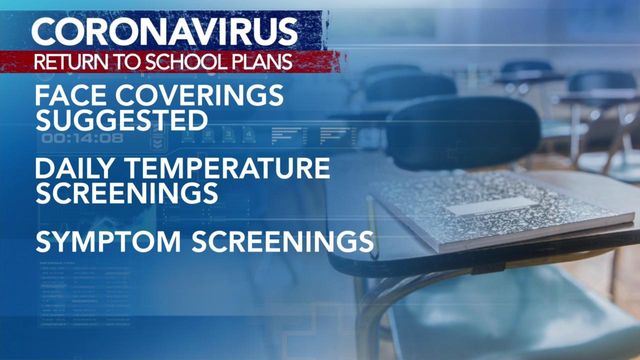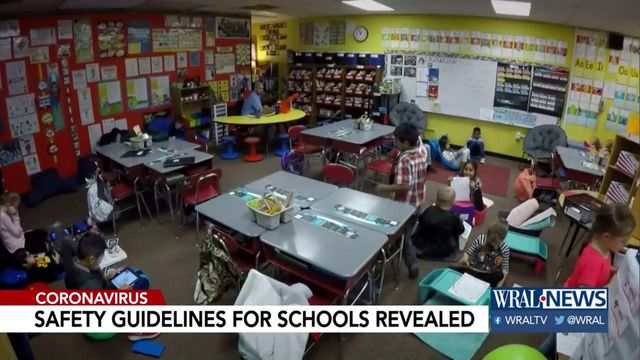DHHS offers checklist for schools as they plan to reopen
State education and health officials on Thursday discussed a plan to allow students to return to schools in the fall. Schools will operate under one of three plans, depending on the severity of the coronavirus in the state.
Gov. Roy Cooper has said a decision would be based on data as of July 1. Most public schools on a traditional calendar are scheduled to resume on Aug. 17.
Schools are being asked to come up with three levels of COVID response, ranging from almost-normal classrooms with minimal social distance requirements to half capacity to students staying out of school and a return to remote learning.
Face coverings will be strongly suggested. Daily temperature screenings of students are required, as are screenings for symptoms like fever, chills, and cough.
Across the state, different districts might be operating under different levels of those limits based on outbreak data.
Cleaning and hygiene requirements and recommendations are also part of the guidance.
Requirements for NC K-12 schools
Social distance
- Provide social distancing floor/seating markings in waiting and reception areas
- Mark 6 feet of spacing to remind students and staff to always stay 6 feet apart in lines and at other times when they may congregate
- Provide marks on the floors of restrooms and locker rooms to indicate proper social distancing
- Limit nonessential visitors and activities involving external groups or organizations
- Have staff monitor arrival and dismissal to discourage congregating and ensure students to go straight from a vehicle to their classrooms and vice-versa
- Discontinue the use of any self-service food or beverage distribution in the cafeteria (e.g. meals and/or snacks served at school should be individually packaged and served directly to students; milk or juice may be available separately and should also be served directly to students)
Face coverings
- Share guidance and information with staff, students, and families on the proper use, wearing, removal, and cleaning of cloth face coverings
Cleaning and hygiene
- Provide adequate supplies to support healthy hygiene behaviors (e g , soap, hand sanitizer with at least 60% alcohol for safe use by staff and older children, paper towels, and tissues)
- Teach and reinforce hand washing with soap and water for at least 20 seconds and/or the safe use of hand sanitizer that contains at least 60% alcohol by staff and older children
- Increase monitoring to ensure adherence among students and staff
- Supervise use of hand sanitizer by students
- Ensure that children with skin reactions and contraindications to hand sanitizer use soap and water
- Reinforce hand washing during key times such as: Before, during, and after preparing food; Before eating food; After using the toilet; After blowing your nose, coughing,or sneezing; After touching objects with bare hands which have been handled by other individuals
- Provide hand sanitizer (with at least 60% alcohol) at every building entrance and exit, in the cafeteria, and in every classroom, for safe use by staff and older students
- Systematically and frequently check and refill hand sanitizers
- Encourage staff and students to cough and sneeze into their elbows, or to cover with a tissue
- Used tissues should be thrown in the trash and hands washed immediately with soap and water for at least 20 seconds
- Incorporate frequent hand washing and sanitation breaks into classroom activity
- Allow time between activities for proper cleaning and disinfection of high-touch surfaces
- Establish a schedule for and perform ongoing and routine environmental cleaning and disinfection of high-touch areas with an EPA-approved disinfectant, and increase frequency of disinfection during high-density times and disinfect all shared objects between uses
- Ensure safe and correct use and storage of cleaning and disinfection products, including securely storing and using products away from children, and allowing for adequate ventilation when staff use such products
- Limit sharing of personal items and supplies such as writing utensils
- Keep students’ personal items separate and in individually labeled cubbies, containers or lockers
- Limit use of classroom materials to small groups and disinfect between uses or provide adequate supplies to assign for individual student use
- Ensure that all non-disposable food service items are minimally handled and washed with hot water and soap or in a dishwasher, or use disposable food service items such as plates and utensils
Screening for symptoms
- Enforce that staff and students stay home if:
- They have tested positive for or are showing COVID-19 symptoms, until they meet criteria for return
- They have recently had close contact with a person with COVID-19, until they meet criteria for return
- Conduct symptom screening of any person entering the building
- Conduct daily temperature screenings for all people entering the school facility or boarding school transportation
The plan also lists requirements for protecting high-risk students and staff, for dealing with suspected cases of coronavirus and for supporting student and staff mental health.
“If our state metrics are positive, local school districts will be able to take steps to safely return students to the classroom while also ensuring schools can accommodate students and teachers who may have health concerns. If, however, our great state takes a turn for the worst all schools will follow more stringent guidance," said NC Superintendent Mark Johnson.
Some parents want kids back in school while others want to wait for it to be safe. But for many, school is a safe haven and a place where they receive structure.
“There are a lot of children out there who rely on the schools for nutrition and guidance, and it’s very important, but we do want all the children to attend when it’s safe," said parent Meredith Terrell.











